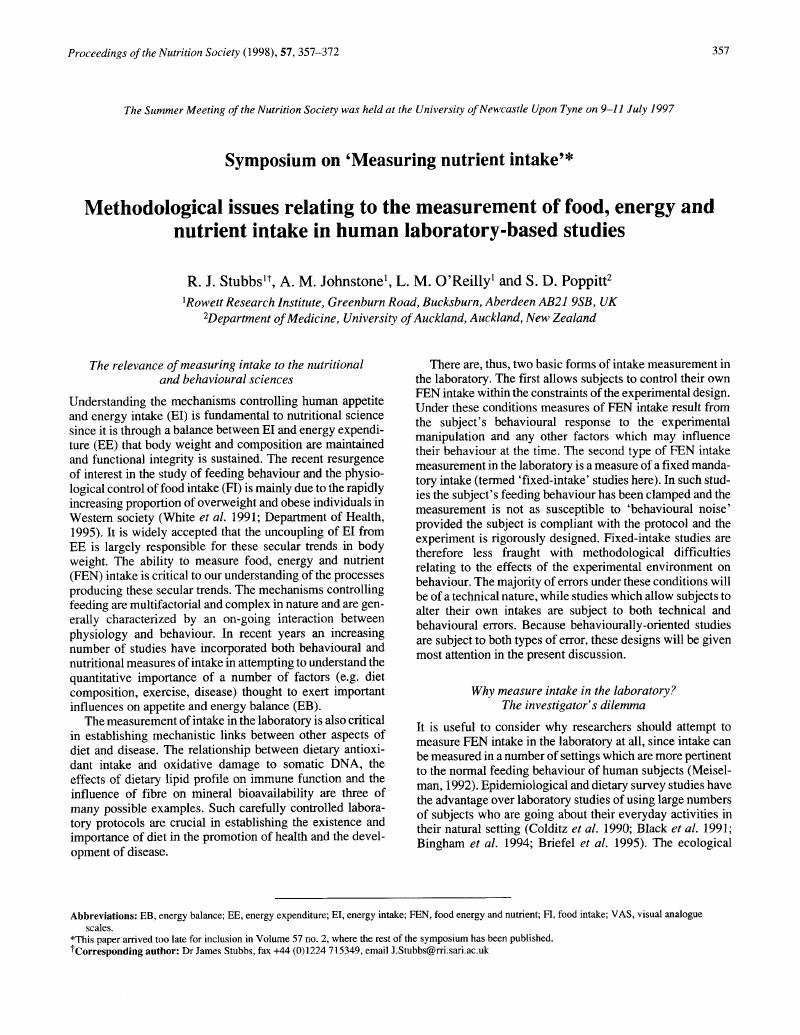Crossref Citations
This article has been cited by the following publications. This list is generated based on data provided by Crossref.
James Stubbs, R
and
O’Reilly, Leona
1999.
Neural and Metabolic Control of Macronutrient Intake.
Gibson, E.L.
and
Booth, D.A.
2000.
Food-conditioned odour rejection in the late stages of the meal, mediating learnt control of meal volume by aftereffects of food consumption.
Appetite,
Vol. 34,
Issue. 3,
p.
295.
Stubbs, R. J.
Hughes, D. A.
Johnstone, A. M.
Rowley, E.
Reid, C.
Elia, M.
Stratton, R.
Delargy, H.
King, N.
and
Blundell, J. E.
2000.
The use of visual analogue scales to assess motivation to eat in human subjects: a review of their reliability and validity with an evaluation of new hand-held computerized systems for temporal tracking of appetite ratings.
British Journal of Nutrition,
Vol. 84,
Issue. 4,
p.
405.
Russell, K.
Sabin, R.
Holt, S.
Bradley, R.
and
Harper, E. J.
2000.
Influence of feeding regimen on body condition in the cat.
Journal of Small Animal Practice,
Vol. 41,
Issue. 1,
p.
12.
Blundell, J. E.
Stubbs, R. J.
Hughes, D. A.
Whybrow, S.
and
King, N. A.
2003.
Cross talk between physical activity and appetite control: does physical activity stimulate appetite?.
Proceedings of the Nutrition Society,
Vol. 62,
Issue. 3,
p.
651.
Simpson, Stephen J
Batley, Rachel
and
Raubenheimer∗, David
2003.
Geometric analysis of macronutrient intake in humans: the power of protein?.
Appetite,
Vol. 41,
Issue. 2,
p.
123.
Appleton, K. M.
Rogers, P. J.
and
Blundell, J. E.
2004.
Effects of a sweet and a nonsweet lunch on short‐term appetite: differences in female high and low consumers of sweet/low‐energy beverages.
Journal of Human Nutrition and Dietetics,
Vol. 17,
Issue. 5,
p.
425.
Whybrow, S.
Mazlan, N.
and
Stubbs, R.J.
2005.
Food, Diet and Obesity.
p.
179.
Cardello, Armand V.
Schutz, Howard G.
Lesher, Larry L.
and
Merrill, Ellen
2005.
Development and testing of a labeled magnitude scale of perceived satiety.
Appetite,
Vol. 44,
Issue. 1,
p.
1.
Whybrow, S.
Mazlan, N.
and
Stubbs, R.J.
2005.
Food, Diet and Obesity.
p.
179.
Stubbs, R. J.
and
Tolkamp, B. J.
2006.
Control of energy balance in relation to energy intake and energy expenditure in animals and man: an ecological perspective.
British Journal of Nutrition,
Vol. 95,
Issue. 4,
p.
657.
Bowen, Jane
Noakes, Manny
and
Clifton, Peter M.
2006.
Appetite Regulatory Hormone Responses to Various Dietary Proteins Differ by Body Mass Index Status Despite Similar Reductions inad LibitumEnergy Intake.
The Journal of Clinical Endocrinology & Metabolism,
Vol. 91,
Issue. 8,
p.
2913.
van Strien, Tatjana
Engels, Rutger C. M. E.
van Staveren, Wija
and
Herman, C. Peter
2006.
The validity of Dietary Restraint Scales: Comment on Stice et al. (2004)..
Psychological Assessment,
Vol. 18,
Issue. 1,
p.
89.
van Strien, Tatjana
Peter Herman, C.
Engels, Rutger C.M.E.
Larsen, Junilla K.
and
van Leeuwe, Jan F.J.
2007.
Construct validation of the Restraint Scale in normal-weight and overweight females.
Appetite,
Vol. 49,
Issue. 1,
p.
109.
Bornet, Francis R.J.
Jardy-Gennetier, Anne-Elodie
Jacquet, Noémie
and
Stowell, Julian
2007.
Glycaemic response to foods: Impact on satiety and long-term weight regulation.
Appetite,
Vol. 49,
Issue. 3,
p.
535.
Martins, Catia
Truby, Helen
and
Morgan, Linda M.
2007.
Short-term appetite control in response to a 6-week exercise programme in sedentary volunteers.
British Journal of Nutrition,
Vol. 98,
Issue. 04,
Shorten, Allison L
Wallman, Karen E
and
Guelfi, Kym J
2009.
Acute effect of environmental temperature during exercise on subsequent energy intake in active men.
The American Journal of Clinical Nutrition,
Vol. 90,
Issue. 5,
p.
1215.
Appleton, Katherine M.
2009.
Increases in energy, protein and fat intake following the addition of sauce to an older person’s meal.
Appetite,
Vol. 52,
Issue. 1,
p.
161.
Anschutz, Doeschka J.
Van Strien, Tatjana
Van De Ven, Monique O.M.
and
Engels, Rutger C.M.E.
2009.
Eating styles and energy intake in young women.
Appetite,
Vol. 53,
Issue. 1,
p.
119.
Fyfe, Claire L
Stewart, Joanne
Murison, Sandra D
Jackson, Diane M
Rance, Kellie
Speakman, John R
Horgan, Graham W
and
Johnstone, Alexandra M
2010.
Evaluating energy intake measurement in free-living subjects: when to record and for how long?.
Public Health Nutrition,
Vol. 13,
Issue. 2,
p.
172.



